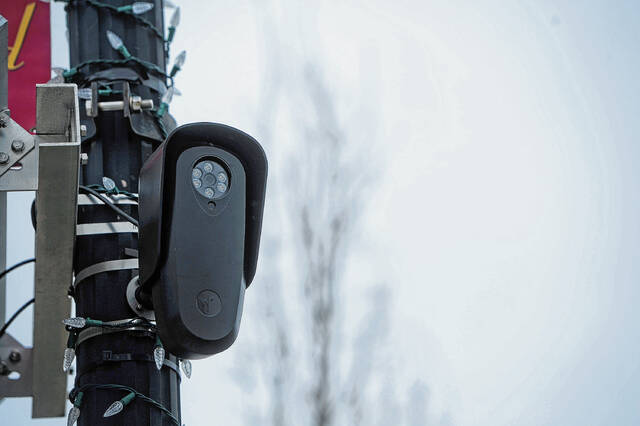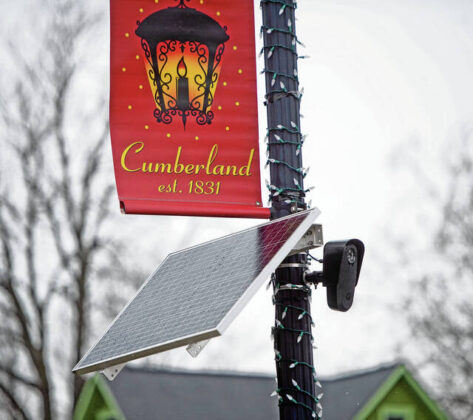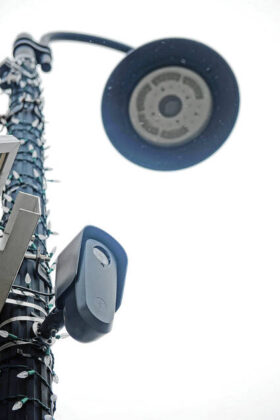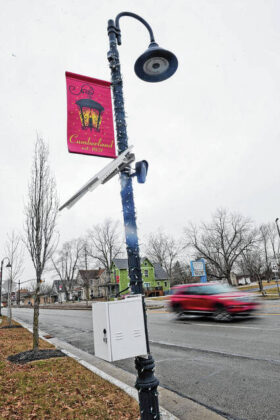
An expanding network of cameras now can look over most of the vehicles that enter Hancock County from Indianapolis, according to the Hancock County Sheriff’s Department.
Tom Russo | Daily Reporter
HANCOCK COUNTY — Small cameras that snap an instant photo of every license plate that rolls past were a major factor in helping police deal with dozens of cases in 2021, said officials with the Hancock County Sheriff’s Department.
The cameras, installed over the past year, have aided investigations ranging from locating missing people to tracking down suspects sought on a variety of criminal charges. Those cases included investigations of criminal mischief, theft, burglary, motor vehicle theft, driving without a license, operating while intoxicated, leaving the scene of a crash, criminal confinement and even attempted murder.
“The Flock cameras are proving to be a very useful tool to help solve crimes in Hancock County,” said Capt. Robert Harris, public information officer for the Hancock County Sheriff’s department, referring to the company that is supplying cameras in the county.
But do the so-called license plate readers actually reduce crime?
Law enforcement officials feel they are a deterrent and are helpful in their work, while others see them as an invasion of privacy. A year after they began being installed along roads throughout the county, police agencies have no plans to stop using them and in fact have increased the number of cameras and connections, which now extend throughout the state.
Police departments in Cumberland, Fortville, McCordsville and Greenfield all have Flock camera systems in place. Plus, many surrounding counties use them as well.
“In total we are sharing over 32 Flock networks including over 350 cameras,” Harris said. “We can view license plate ‘hits’ and search cameras from as far north as almost Michigan to as far south as Georgia.”
The sheriff’s department, which covers the most territory, bought its first 15 cameras almost a year ago at a cost of about $2,500. The department now has a total of 22 cameras.
The department initially started with cameras on the Marion-Hancock county line, north of U.S. 40, and expanded the line south to County Road 600S. That includes locations in New Palestine at County Roads 800W, 600S, Stinemyer Road, U.S. 52, 300S and 200S.
“This allows the department to capture almost any vehicle entering the county directly from Indianapolis,” Harris said.
The department recently added cameras on State Road 9 at both the north and south ends of the county and additionally has cameras on State Roads 109, 234, and U.S. 40, capturing images of vehicles entering the county near Shirley, Wilkinson and from Knightstown.
Paul Casey, chief of police for the McCordsville Police Department said the department signed a two-year contract for six cameras about a year ago. While he does not anticipate adding more, that could change.
“From a global perspective, I think the cameras are working as intended and providing us with another tool in our tool belt to help fight crime both proactively and on the investigative side,” Casey said.
Sheriff’s deputies on patrol and in their investigators use the cameras — which are on poles in static locations — every day searching for possible suspects, travel routes of criminals and more, Harris said.
“Almost every day, we develop some kind of information from Flock cameras that helps move investigations forward,” Harris said.
Many of those investigations may have stalled or taken much longer to resolve if the network was not available.
“The true number of times Flock has so far helped us develop information or solve a case is hard to accurately measure, but would number in the hundreds,” Harris said.
During the first few months the department started using the system, some residents raised privacy concerns. Sheriff Brad Burkhart, Maj. Robert Campbell and Harris have taken the time to personally speak to everyone who wanted to know more about the police tool.
“After discussions, each person understood the cameras and their use,” Harris said. “Most privacy concerns by residents were born out of misinformation or false rumors; once we provided facts and explanations, those concerns went away.”
The cameras only issue alerts on plates that have been entered into a database, so agencies are tagging only vehicles they have reason to be looking for, Harris said. That means that for the most part, the average citizen who has done nothing wrong will not have their movements tracked.
On a national level, it is estimated that police departments in more than 1,000 cities have access to cameras, which are not only detecting license-plate information but also people, cars, animals and bicycles, according to those who object to their use.
A digital privacy group, the Electronic Frontier Foundation, has criticized the technology and companies like Flock, claiming there is no real evidence that their use reduces crime and that the technology is a poorly regulated surveillance tool.
The technology has been around for nearly a decade. The American Civil Liberties Union, which studied police agencies’ use of the cameras, issued a warning in 2013 about the potential for abuse.
“Automatic license plate readers have the potential to create permanent records of virtually everywhere any of us has driven, radically transforming the consequences of leaving home to pursue private life, and opening up many opportunities for abuse,” said its report. “The tracking of people’s location constitutes a significant invasion of privacy, which can reveal many things about their lives, such as what friends, doctors, protests, political events, or churches a person may visit.”
The Brennan Center for Justice, in a report in September 2020, suggested events such as protests and even the pandemic may be crystalizing concerns. A number of police agencies, it said, are using the cameras to monitor protesters at large demonstrations. In the early months of the COVID-19 outbreak, at least one state directed agencies to look for out-of-state license plates so they could identify visitors who should be directed to seek quarantine, the organization said.
Agencies here insist they are using the cameras only to solve crimes and find missing people.
Burkhart has been working with proposed and existing neighborhoods and businesses to tell them of the usefulness of the camera systems, hoping they’ll invest in a camera system themselves.
“I’m in favor of them,” Burkhart said. “I’ve seen first-hand how they can help keep a community safe, and that’s what we’re interested in doing.”
The neighborhoods and businesses would pay for the camera themselves, but if they install a Flock camera, they could then share an alert image with law enforcement agencies.
“It expands our network at no cost to the residents of the county,” Harris said.
While law enforcement officials in New Palestine have not purchased any cameras, Chief Bob Ehle said they use the ones county officials have put up as well as ones in Indianapolis.
“We do have access to those cameras, and we’ve utilized them quit a bit,” Ehle said. “They really are helpful.”







